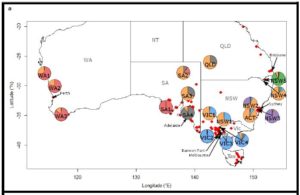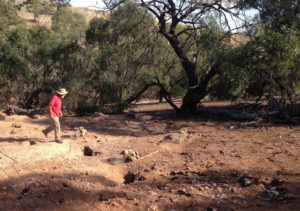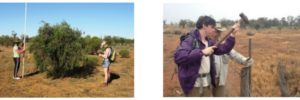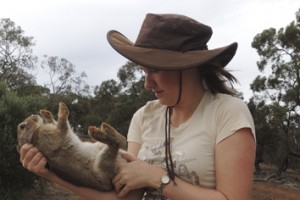In this section
Rabbit Controls
- Alternative Baiting Trial
- International Lagomorph Conference Attendance
- Rabbit gene differences around Australia
- Modelling invasive European rabbit distribution in Australia
- Potential effects of new biological controls on rabbit populations
- Flies as RHDV monitors
- Genomics of resistance
About Rabbits & Rabbit Impacts
- Open Access – Finlayson et.al.
- Rabbit impacts on ground layer plant communities
- Heatwave impacts on rabbits and native burrowers
- 90 Years & Still Changing – Koonamore Reserve
Previous investments
Recent research supported by the Foundation for Rabbit-Free Australia include:
Alternative Baiting Trial
Bush Heritage Australia control rabbits in southern WA as part of an integrated predator management program. A trial of alternative baits (carrots, whole oats and rolled oats) over two years was confounded by field events (such as high mouse populations, rabbit behaviour with a few rabbits becoming ‘regulars’ to the site for free-feeding, and de-husking of grain by some birds and rodents) but results indicate that whole oats were the preferred option for free-feeding. Further work is required to explore that preliminary conclusion and the implications for baiting.
The trial highlighted the importance of free-feeding to get rabbits used to the bait, prior to introducing treated baits for rabbit control. It also helped the team appreciate the need for an expansion to their rabbit control program, which was subsequently doubled in size.
For more information, see the Final Report.
Open Access – Finlayson et.al.
In the interests of ensuring as wide a readership as possible for important journal articles, the Foundation has covered the costs of ‘open access’ publication for a keystone report on the effect of rabbits on Australian ecosystems; Finlayson G, Taggart P & Cooke B. ‘Recovering Australia’s arid zone ecosystems: learning from continental-scale rabbit control experiments.’ Restoration Ecology. Vol 30 Issue 4.
This report presents a treasure trove of evidence from around 100 different papers into the effect of rabbits on the environment in Australia.
The ‘take-home’ messages are:
- Rabbit bio-controls have been incredibly effective in reducing rabbit numbers.
- Reducing rabbit densities allows vegetation to recover, and that leads to the recovery of native fauna.
- Reducing rabbit densities is also a driver of the long-term reduction of feral predators like cats and foxes.
- The effectiveness of bio-controls wanes over time, and new ones will be needed.
- On their own, biological controls do not keep rabbit numbers low enough to stop them determining which plant species get to grow and which don’t.
Rabbit biocontrol has been a tremendous success story – probably one of the most environmentally beneficial programs in Australian history. It is a credit to the many researchers and investors involved and their commitment over many decades, and to the thousands of land managers who have played their role alongside the release of the bio-controls.
International Conference Attendance
Dr David Peacock was able to accept an invitation to attend and present at the 6th World Lagomorph Conference and workshop in France, July 2022; thanks to Rabbit-Free Australia covering major travel costs. Attendance enabled David to hear, and contribute to, the latest thinking about rabbits and hares from researchers across the world, and to explore opportunities for future collaboration. He was particularly keen to investigate the feasibility of a herpes virus as a form of rabbit control, but also discussed rabbit diseases in general, factors affecting rabbit survival, and the unique data available from the long-term monitoring site at Turretfield (SA).
David came away from the trip with a wealth of new ideas and information, new and renewed contacts, and the prospect of collaborations between Australian researchers and international leaders in their fields. For more information, see the Summary Report of his trip.
Rabbit gene differences around Australia
Previous research, supported in part by Rabbit-Free Australia, sequenced DNA from rabbits around the country and found that they form 6 genetic clusters, indicating there were multiple introduction events during European colonisation. In this project, Amy Iannella investigated which genetic loci differentiated those clusters, and whether those differences are connected to genes that could cause varied susceptibility of rabbits to RHDV.
The investigation discovered one candidate RHDV resistance gene, differentiated based on rabbit ancestry. The differentiating gene, called MHC class 1, is a major immune gene which could also impact resistance to other infectious diseases such as myxomatosis. The most common MHC class 1 variant in Western Australia and South Australia appears to differ from that of the eastern states.
The methods developed in this study will allow rapid testing for geographic differentiation of any newly identified resistance genes as other studies across the globe continue to uncover the genetic causes of RHDV resistance.
The project method was:
- Run all available rabbit sequence data through the analysis pipeline from Iannella 2018 to characterise the genetic markers for each cluster.
- Use four independent software packages (Bayescan, fsthet, Arlequin and FLK) to find genetic markers that differentiate rabbit clusters. Create a list of consensus markers from these software.
- Identify genes in close proximity (within 40kb) to the consensus markers following Schwensow 2017’s methods.
- Compare the identified genes to those identified by Schwensow 2017 as correlating with RHDV survival.
- Document results as a manuscript for scientific publication, and as an article for public communication.
For more information, see:
- Summary Article – Should we care that rabbit genes are different around Australia?

Map of rabbit genetic clusters.
Modelling invasive European rabbit distribution in Australia
University of Adelaide PhD student, Emilie Roy-Dufresne, was assisted by RFA in a project to model the distribution and population dynamics of wild European rabbits in Australia. The work included mapping the potential invasion range of wild rabbits in Australia, testing how model predictions change when micro-habitats are considered, and developing a pest management modelling framework for wild European rabbits that accounts for varying demographic rates, habitat suitability, dispersal processes, and density-dependent processes.
RFA assisted with funds for training in statistics and Bayesian modelling, and attendance at an international scientific conference. Emilie was subsequently a contributor to a paper by Brown et.al. ‘Models of spatio-temporal variation in rabbit abundance reveal management hotspots for an invasive species‘, published in EcoEvoRxiv Preprints.

Source: Brown et.al., 2019. Percentage of time spent in hotspot conditions for high rabbit abundances.
Potential effects of new biological controls on rabbit populations
Flinders University research associate, Dr. Louise Barnett, was helped by RFA to better understand how the myxomatosis and RHD viruses interact. Eighteen years of mark-recapture, dead recovery, and antibody assay data from Turretfield (SA) has been used to model the impact of myxoma and RHD on the survival of rabbits with different exposure histories – indicating that rabbits previously exposed to myxoma are more susceptible to RHDV. That information suggests that new pathogens could reduce rabbit survival by a substantially greater margin than their individual effects measured in isolation from other pathogens.
RFA funding helped Louise with model enhancement to enable the potential impact of new pathogens to be better predicted. A paper submitted to the Journal of Applied Ecology presents findings from this research and a ‘progress report’ presentation, ‘Using the Turretfield rabbit population to assess the impact of myxomatosis and rabbit haemorrhagic disease‘, was given at a RFA Annual General Meeting.

Photo Source: Louise Barnett. Field site.
Flies as RHDV monitors
It is now accepted that flies are a major vector for the transmission of RHDV. Thanks in part to former RFA funding, research also showed that flies could be used as an easier way to measure the spread of the virus within rabbit populations compared to relying on rabbit carcasses – but an efficient sampling and analysis were not available.
Dr Adam Croxford, at the University of Adelaide, used RFA and PIRSA funding to investigate a method for optimum extraction of RHDV viral RNA from bulk samples of flies, seeking a better sampling option to make it easier to monitor and understand the spread and interactions between various forms of RHDV, resulting in better rabbit control programs. The work helped develop freeze drying and bulk analysis processes and contributed to a method now employed nationally by CSIRO.
For more information on the project, see the proposal ‘Monitoring RHDV in flies’ and final report ‘Fly surveys for monitoring RHDV2‘.
Rabbit impacts on ground layer plant communities
Foundation for Rabbit-Free Australia supported Neil Ross from the University of NSW to conduct field work in semi-arid areas of NSW and SA to monitor growth within and outside of long-term rabbit exclosures, to better understand the impact of rabbits and the benefits of rabbit control for plant communities. Some rabbit grazing impacts can be generations in the making. By looking at old exclosures, it is hoped to detect any long term changes in plant communities.
Conclusions from the study include:
- Rabbits are likely to be keeping Australian rangelands suspended in a degraded state with increased weeds and inhibited recruitment of woody species.
- Rabbit control can facilitate rangeland recovery, but their control alone may be insufficient, e.g. where historic seed banks have been lost.
- Improvements in rangeland condition through rabbit control can be facilitated under kangaroo grazing, as long as kangaroos are not over-abundant.
For more information, see:
- Project Summary. Rabbits still affect Australian rangelands.
- Final Report. Rabbit impacts on ground layer plant communities in arid rangelands.
Heatwave impacts on rabbits and native burrowers
Dr Katherine Moseby and Jack Bilby (University of NSW) used monitoring equipment in burrows and on GPS collars to explore how heatwaves affect the behaviour and survival of rabbits, bilbies and bettongs at the Arid Recovery wildlife reserve in rangeland SA. Foundation funds assisted with the purchase of monitoring devices.
Early results from the study show that wild radio-collared rabbits are consistently exposed to higher temperatures and lower humidity than bilbies. It seems that rabbits are coming to the entrances of burrows, or leaving them altogether, to avoid the humidity of warrens; while bilbies remain deeper underground. Further research will build on this project to confirm the results and provide additional behavioural information.
The results indicate how different species may fare under a warming climate and whether that might influence future rabbit control options.
For more information see:

Temperatures and humidity experienced by rabbits & bilbies. Source: K Moseby 2023.
90 Years & Still Changing – Koonamore Reserve
The Koonamore vegetation monitoring reserve shows rabbit control is essential for the regeneration of many tree and shrub seedlings – and a donation from RFA helped with re-fencing. Thanks to funding support from RFA and others, Koonamore – the longest running vegetation monitoring project in Australia – has been able to upgrade part of the reserve’s rabbit-proof boundary fencing.
Officially titled the TGB Osborn Vegetation Reserve, Koonamore Station, the 4km square reserve is managed by the University of Adelaide and an enthusiastic team of volunteers, lecturers past and present, and students. The site is used by students and researchers from both Adelaide and Flinders universities.
For more information, see ’90 Years of Change. The TGB Osborn Vegetation Reserve, Koonamore’, or search for ‘Koonamore’ videos of photopoint sequences on Youtube.
Genomics of resistance
A RFA supported PhD scholarship (Amy Ianella) mapped out the family trees of rabbits to see if genetics were behind an apparent increase in resistance, or whether it was more due to seasonal factors like the abundance of insect vectors and the innate resistance of very young rabbits (who, if infected, retain that immunity for life). The study found that a small number of older rabbits were disproportionately responsible for the majority of surviving offspring, indicating a genetic factor at play. However, seasonal factors also affected survival rates, probably through a combination of feed availability and seasonal disease outbreaks.
For more information see the project report or media article.
Former investments in research by the Foundation for Rabbit-Free Australia included:
- Enabling attendance at the Australasian Vertebrate Pest Conference by young CSIRO researcher, Emilie Roy-duFresne, and Foundation Chair Prof Wayne Meyer. Emilie presented a paper on work modelling the distribution and population dynamics of wild European rabbits in Australia. Her presentation showed the likely benefits of population modelling, which may be of use to other pest species as well.
- A contribution to the ‘RHD Boost’ project, through the Invasive Animals CRC, to evaluate possible new strains of RHD for Australia and to prepare for their release.
- A Postgraduate Research Grant awarded to Maija Marsh whose research project was titled ‘Causes of local variation in the impact of RHDV on rabbit populations’. This grant supported a visit by Dr Piran White from the University of York, UK, to provide assistance with fieldwork, collaborate more closely with Maija and other Australian researchers, and to develop further joint research topics on RHDV dynamics and rabbit control. Extra funding was also provided to enable Dr. White and Maija Marsh to travel to Adelaide and give a seminar to RFA members.
- Two small research grants provided through the Royal Zoological Society’s scholarship scheme.
- Support for Dr. Katherine Moseby, Roxby Downs, to extend information from a rabbit control project, involving the radio-tracking of rabbits to understand their behaviour – such as time spent in burrows and grazing. It showed that home ranges were larger in winter than summer.
- Josh Griffiths, The University of Adelaide, with logistic support for a project on competition between rabbits and bilbies. It involved radio-tracking bilbies in the wild at Venus Bay and at Roxby Downs, and showed that males roamed much further than females – covering up to several kilometres in an evening.
- A travel grant to allow Greg Mutze, Senior Research Officer from the then Animal and Plant Control Commission, to attend the 2nd International Lagomorph Conference in Portugal, and to consult with scientists at an RHD laboratory in Italy. S Kidman & Co provided additional funding through RFA.
- A Rabbit Calicivirus Research Project, co-funded with S Kidman & Co.
The Foundation has been active in building the capacity of Australian research infrastructure to be effective in rabbit control research. Activities have included:
- Co-hosting a national webinar with CISS providing a Rabbit R&D Update, including presentations on the environmental and economic benefits of rabbit bio-controls, the ecology of calicivirus, and how Easter Bilby can help promote rabbit control.
- The Chair of RFA chaired the RHDV K5 Operations Working Group supporting research to boost the impact of RHD, especially in cooler, wetter regions of Australia. The ‘Boost’ project evaluated different strains before identifying a South Korean variant (K5) as being most prospective. The Working Group brought key stakeholders together to assist in managing the release of the K5 variant across Australia’s rabbit infested lands.
- Convening a National Workshop on Rabbit R&D Directions in 2005, which stimulated Meat & Livestock Australia and Australian Wool Innovation to develop a grazing industry strategy for rabbit management and abatement. RFA’s predecessor had convened a major conference in 1993, which was important in garnering support for research into, and the release of, the RHD virus.
- Membership of the National Rabbit Management Advisory Group, a body jointly funded by Australian Wool Innovation and Meat & Livestock Australia and convened by the Invasive Animals Cooperative Research Centre, to provide national strategic and practical advice on the planning, implementation and delivery of rabbit research and development programs and their outcomes.
- Supporting the establishment of the Invasive Animals CRC with letters of support and contact with government agencies and Ministers.
- Sponsoring a rabbit session at the 2008 Australian Vertebrate Pests Conference, and a 2007 seminar on the impact of RHD.
- Contributing to a CSIRO Division of Sustainable Resources ‘Rabbit Conference’, in 2001.


